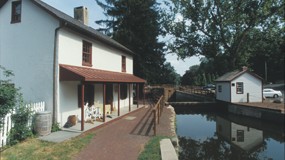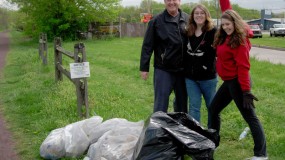Canal News – Fall 2016
Working Through It
What a summer! It’s been hot, hot, hot, but that hasn’t stopped the action along the Delaware Canal.
The Good
Hurricane Hermine did not wreak any havoc.
After the discovery of numerous sinkholes in Smithtown and Point Pleasant, areas notorious for leaks, DCNR quickly engaged Bi-State Construction to fill them with clay and regrade the towpath bank. With these sinkholes repaired, it is hoped that the Lehigh River water coming from the north will flow further south than it has since the Kleinhans Aqueduct problem.
No more walking on the shoulder next to whizzing cars thanks to PennDOT’s Route 13 improvement project. Park visitors now can use a sidewalk to get from the towpath to the Green Lane intersection in Bristol Township. Still to come is a pedestrian crossing south of WaWa on Green Lane with pavement markings and flashing signals. This project is being facilitated by the Pennsylvania Environmental Council.
After thorough investigations by DCNR staff, Sanders Power Company, and Campbell Electric, it has been determined that the 6,000 gallon per minute centrifugal pump that the friends purchased in 2003, before the floods, can be installed in the Delaware River at the northern “Bowman’s Hill” section of Washington Crossing Park. This pump can augment the flow in the watered-starved Canal when the River drops below the level of the New Hope inlet. Approval to operate the pump must be secured from the Delaware River Basin Commission.
By relieving DCNR of the purchase of the new pump at Centre Bridge, the Friends have enabled the Park to undertake the following wall projects: the repair of the concrete wall on the east side of Lock 5 in Yardley, the repair of the stone wing wall on the southwest end of Lock 5, the repair of the stone retaining wall north of Locks 22-23 by the Locktender’s House at the Theodore Roosevelt recreation Area in Raubsville, and the repair of the stone retaining wall along the towpath underneath Woody’s Bridge in Williams Township. Woody’s Bridge is one of the remaining six authentic camelbacks. By investing $27,000 in the Centre Bridge pump when the Park most needed it, the Friends have leveraged a $44,000 expenditure in wall repairs by DCNR.
The Not-So-Good
The hope of having water diverted from the Point Pleasant Pumping Station into the Canal has been dashed, at least temporarily, because of the continuing drought and the well contamination problems in Bucks and Montgomery Counties. The Forest Park Water Authority must retain water for its customers.
The Bad
The water levels in the Canal from New Hope south to Bristol range from very low to bone dry. The heat waves and drought have dropped the level of the Delaware River below the level of the New Hope inlet located behind Odette’s. When the gauge measuring the river level at Trenton, NJ reads less than 9 feet, there is no water entering the Canal. Water levels can be checked online at water.weather.gov – National Weather Service Advanced Hydrologic Prediction Service. After all that Hermine forecasting hype, it would have been nice to have a moderate amount of rain.
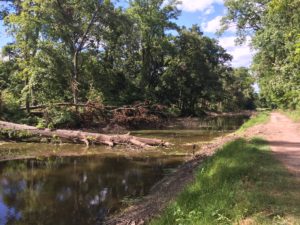
In July, tornado-like winds ripped through the Bowman’s Hill area. Enormous trees fell – more than a few of them into the Canal. DCNR brought in crews from other parks to deal with the immediate damage, but there is still much cutting and removal to do. Falling trees have plagued the Canal ever since Hurricane Sandy. It seems that a tree clearing contingent might need to be added to the Park maintenance staff or perhaps some assistance from the private sector.
As always, the Friends endeavor to meet the Canal’s challenges – in a multitude of ways.
On the Road to Perfection
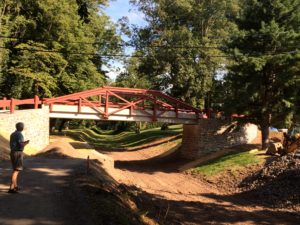
The reconstruction of the Redfield Bridge by Bi-State Construction is nearly complete. It crosses the Canal just north of Centre Bridge. Towpath users are ecstatic to be able to travel their PA/NJ Loop Trail again, and the Friends are tremendously pleased to have the reconstruction reflect the years of incremental work that has gone into creating a bridge design that conveys the Canal’s historic character while accommodating 21st century needs.
Bridges have always been of special interest to the Friends. Our organization has restored three of the six remaining authentic camelback bridges. The fourth was restored through the Save America’s Treasures program. At our urging, the DCNR engineers prepared a detailed guidebook for the repair of all six.
Nearly twenty years ago, after seeing each new Canal bridge have a different look, the Friends collaborated with the firm of Simone, Jaffe, Collins on the production of prototype bridge designs that could accommodate different traffic carrying capacities. The basic prototypes influenced PennDOT’s design decisions for five canal-spanning bridges and counting. As each bridge was built, the basic design was evaluated and improvements incorporated into the plans for the next.
Over the past several years, DCNR has been replacing the Canal bridges that it owns and maintains. Generally, the bridges provide required access to private property, either connecting the property to public roadways or other parts of the property itself. Once again design became an issue. The “commonly understood” faux camelback truss and guiderail designs to be used for the new bridges proved not to be so understood. The construction of the bulky Upper Limeport Bridge was a turning point. After the Friends cried “foul,” DCNR agreed to reconsider its design process, especially since several more bridge replacement projects – Redfield, Lower Limeport, and Phillips’ Mill – were in the pipeline. DCNR hired the Wilson Consulting Group of Mechanicsburg, PA to undertake the development of a different, more historically and contextually correct bridge design. Bill Wilson, principal of the firm, undertook the task with tenacity and enthusiasm consulting with the Pennsylvania Historical and Museum Commission and the Friends.
One of the key goals of the new design was to have Delaware Canal bridges reflect the delicacy of the original camelbacks while meeting current day requirements. New materials, technology and creativity have allowed that goal to be met. The Redfield Bridge is the first bridge to fully utilize the new design standards, and, although there are still some small wrinkles to be ironed out, Redfield Bridge is, by far, the best yet. The Bi-State Construction masons did a particularly fine job with the stone masonry.
DCNR continues with its bridge replacement projects with the Lower Limeport Bridge next up. Bi-state Construction has won the bid, and installation of the coffer dams and pipes to allow water to flow in the Canal is expected to get underway in late fall or early winter. May this bridge be even better.
Park Manager’s Report
We have been working on several projects over the summer and have recently competed some emergency sinkhole repairs. In the beginning of August, after a heavy rain storm, the Park maintenance crew discovered several large sinkholes between Bridges 2 and 3 to the Smithtown section of the Park. Upon closer inspection it was determined that there were more than a dozen sinkholes, with additional holes in the Mountainside Inn section of the Park. Over the course of three weeks Park maintenance staff and contractors were able to excavate the sinkholes, line them with bentomat, pack them with clay, cover them with topsoil, and reseed the berm of the canal. Repairs were completed the last week of August and the canal has been re-watered.
The Redfield Bridge project is coming to an end. The finishing touches are being made to the towpath, some minor adjustments being made to the trusses, and some clean up and restoration work being completed at the work site. Final inspection of the project should be forthcoming.
There are also two upcoming projects where the bids have been awarded. The Mile Post 21 wall repair project and the Lower Limeport Bridge replacement should be starting within the next few months.
Finally, there will be a maintenance draw down of the Canal during the last week of September. Due to regulations regarding the endangered red-bellied turtle, all de-watering activities must occur prior to October 1st. The draw down will enable the Park to work on several small wall repair projects, to conduct inspections of the canal prism, and to perform preventative maintenance.
Enjoy the Canal!
Good Neighbors Make Good Fences
The growing season is drawing to a close at the Locktender’s House garden in New Hope. Goldfinches and squirrels are squabbling over the sunflowers, and there are enough tomatoes to share with passersby.
When the Friends restored the Locktender’s House in 1993-94, the grand plan included not only the creation of the “Life at the Lock” exhibit inside, but also the creation of a period vegetable and flower garden in front. Since locktenders and their families typically had gardens for their own use and to grow produce that could be sold to canal boat crews, the establishment of a garden seemed a natural. Friends’ volunteers transformed a grass patch into a fine plot surrounded by a white wooden picket fence typical of the period. It has become part of the overall story of “Life at the Lock” and delights visitors who enjoy its beauty and engage the volunteer gardeners in conversation.
Over the years, the white picket fence took beatings from both nature and vandals. Repairs were routinely made, but by last year, it was clear that it was time for a new fence. To the rescue came the Dames of Rocksville Questers, who after hearing about the garden at a Friends’ presentation, selected the fence project as the recipient of their annual preservation grant. In April, members of the group arrived at the Locktender’s House with a $900 check. The funds were promptly spent on fencing materials, and member Josh Gradwohl started to construct the fence from scratch. No premade sections for Josh. New posts were installed, and volunteers spent a morning staining the pickets. Josh and Jerry Taylor then proceeded to make a fence materialize, just in time for the grapevines to call it home.
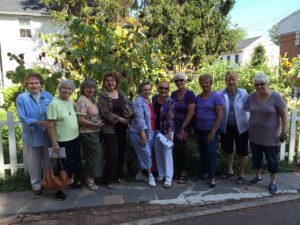
The Friends are very grateful to the Dames of Rocksville Questers for making the fence replacement possible. Half of the $900 grant was provided by the Dames chapter and was matched by the State Quester organization. The Dames of Rocksville Questers originated in Holland, PA and now includes more than 15 members from the Lower Bucks County area. Questers is a non-profit organization which encourages an appreciation for antiques and the preservation and restoration of historic sites.
Our talented and willing volunteers took the contributed materials and transformed them into a handsome, strong fence, and we are very appreciative.
No, It’s Not Algae
Blankets of green appeared on the Canal’s water surface this summer. This green isn’t new, it starts to appear every year around May. Its bright chartreuse hue and abundant growth make it hard to miss.
But what is it?? It’s not algae or slime or an invasive. It’s duckweed – a plant that has many good qualities.
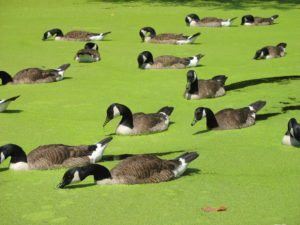
Lesser Duckweed (Lemna minor) is one of the smallest flowering plants in the world. It consists of just two leaves and a root. Duckweed likes to grow in warm, slow-moving, nutrient rich freshwater environments, which makes the Delaware Canal an ideal habitat for this tiny plant.
What is duckweed good for?
Food: Duckweed contains twice the protein, fat, and nitrogen and phosphorus of other similar plants. Its high nutritional content makes it an excellent source of food for waterfowl and fish. (Carp are particularly fond of it.) It is a primary food source for migrating waterfowl.
Shade: A mat of duckweed shades the water below, inhibiting the growth of algae and other plants that can choke nutrient-rich waterways.
Cleansing: Duckweed can help lower water pollution levels by absorbing nitrates, phosphates, and ammonia, which are chemicals found in fertilizers and waste water. It is often used as a biological treatment for waste water from large-scale commercial farms.
Reuse: After it is easily skimmed from the water, duckweed can be fed to animals and poultry and used as compost or fertilizer.
In the height of summer, duckweed can obscure the scenic value of the Canal, but is has its benefits and is far better for the environment than algae and invasive plants. And if you want a great addition to your compost pile, feel free to skim some off and take it home.
Thanks to Ian Kindle, Delaware Canal State Park Educator, for providing this information and photo.
’tis the Season to Buy
Why not benefit, too?
If you are planning to use Amazon for holiday shopping this year, please remember that the Friends of the Delaware Canal is eligible to receive contributions from the AmazonSmile Foundation. Designate the Friends when you make a purchase from Amazon, and the Friends will receive a contribution.
Here’s how it works. Visit AmazonSmile on the internet, and choose Friends of the Delaware Canal as your charitable organization. For eligible purchases, the AmazonSmile Foundation will donate 0.5% of the purchase price to the Friends. It’s a quick and easy way to spread holliday cheer not only to the peo0ple on your gift list, but to the Friends, too.
As Close as We’ve Come to Going Viral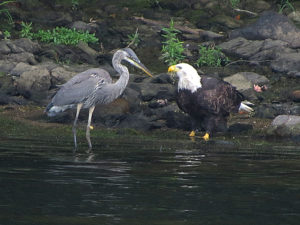
Nearly 450,000 people have seen this photo of a bald eagle and a great blue heron on the Friends of the Delaware Canal Facebook page. When all the views are in, we may even reach a half million!
Carole Mebus, Friends’ member and photographer extraordinaire, shares her photos with the Friends, and we post them on Facebook. In case, you weren’t among the many who saw the post, here’s the story of her amazing encounter.
On September 3, Carole embarked on a neighborly bird identification mission, but she never got to there because something caught her eye. “Across the River at the northern end of Canal Road in Raubsville was a fascinating sight. I took 96 pictures of a great blue heron and a bald eagle sharing a meal. When I first came on the scene, the eagle was eating the fish and the heron was looking on. They changed positions often from the log to the ground. It seemed like a sizable fish, and eventually the heron had some of it. Two crows even showed up briefly. How do I see things like this? I’m always looking around. And I am really lucky sometimes. It made my day.”
If you would like to see seven of the 96 photos, visit the Friends’ Facebook page, and while you’re there don’t forget to “Like” it. It’s hard to imagine that Carole won’t have more to share.
More Canal Tenders on Task
Three new Canal Tenders answered the call for help in the summer issue of Canal News. Thank you! Jim and Katie Wolf have adopted the Bridge Street to Lock 9 section of the Canal in New Hope. Harry Dozer will be providing weekend assistance to Peter Shaw in taking care of the Bridge 3 to Bridge 2 stretch in Smithtown.
Only 5.4 miles of the Canal are still orphans. Wouldn’t you like to adopt one? Find out how by going to www.fodc.org and clicking on HELP on the navigation bar.
Welcome, New Friends
Alan Bader
Janice Burgh
Neysa Garrett
Peggy and Mike Probst
Jeffrey Revak
Scannapieco Development Corporation
David Seidman
Greg Silk
Mitchell Zuckerman
